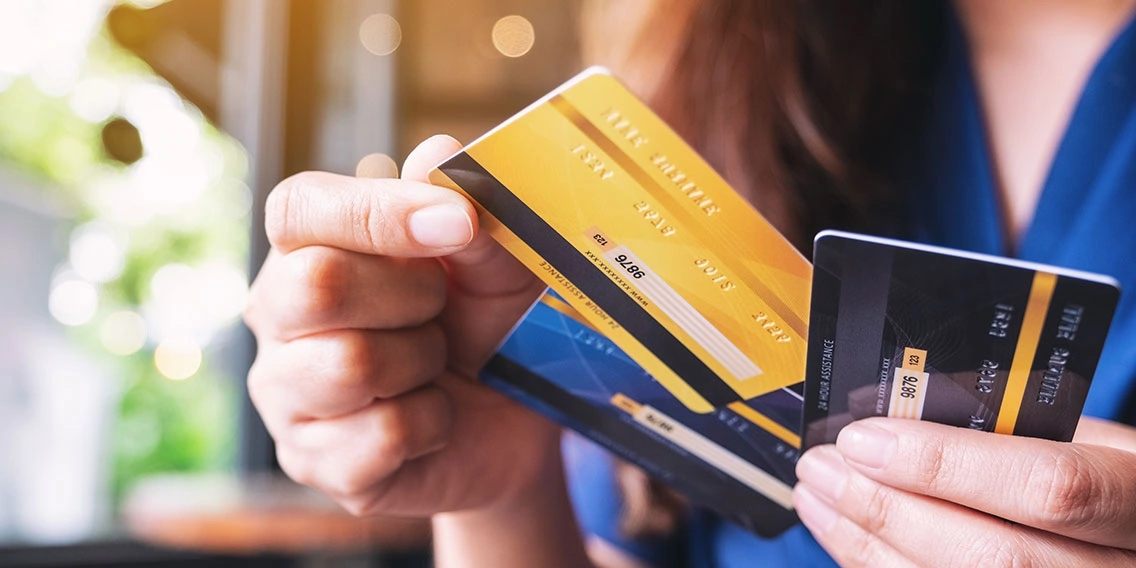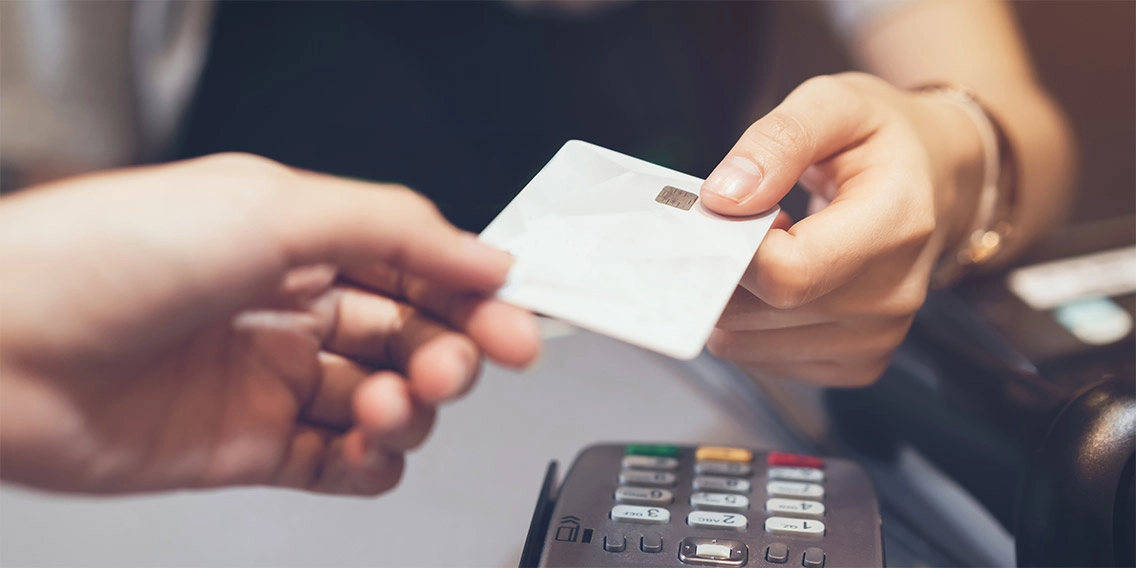CREDIT CARDS
How Credit Cards and Credit Card Interest Actually Work
EXPECTED READ TIME: 8 MINUTES
As simple as credit cards are to use at the point of sale, each transaction requires a surprising amount of computerized coordination and collaboration behind the scenes. Verifications and authorizations. Postings and reports. Fees and assessments. Call it the paradox of plastic.
Technology removes you from this electronic interplay so you don't necessarily need to worry about the particulars of payment processing when you swipe, tap, or insert your card at the checkout. Now we're pulling back the curtain for an inside view on how credit cards really work.
How Credit Cards Work
When a financial institution approves you for a credit card, it's agreeing to loan you money up to a predetermined amount. This figure, known as your credit limit, is based on your income, credit history, and other information included on your credit application.
By signing and activating your credit card, you're promising to repay what you spend, plus interest and any fees outlined in the terms and conditions. You can then use your card to pay for goods and services at any business that accepts credit as payment. You can also use it to take out a cash advance.
What Happens When You Use a Credit Card?
Each time you pay with plastic, you trigger a chain reaction of digital interactions between various companies.
Here's how this complex process would play out if you used a credit card to buy a new pair of shoes at your favorite retail outlet:
- You insert, tap, or swipe your credit card on a processing machine, which sends the transaction details electronically to the shoe store's bank.
- The shoe store's bank then requests electronic authorization from the credit card network (think Visa®, MasterCard®, Discover®, and American Express®). This request is also routed through the credit card issuer to validate the card number, credit limit, and security code.
- The credit card issuer either approves or declines the transaction and sends this response to both the credit card network and the shoe store's bank.
- If the sale is approved, the shoe store — otherwise known as the retailer — completes the in-store transaction. Meanwhile, your credit card issuer puts a hold on your account for the amount of the sale, which decreases your available credit on the card.
- When the store closes, the shoe store sends your transaction along with all other credit card sales made that day to its bank.
- The shoe store's bank then sends batches of transactions to the appropriate credit card network — including the one connected to your credit card account — for processing.
- The credit card network routes your transaction to the financial institution that issued your credit card. The card issuer then sends payment back to the credit card network.
- Once it receives funds, the credit card network pays the shoe store's bank, which then reimburses the shoe store, minus applicable processing fees.
Now, consider that this process is repeated each time you use your credit card, whether online or in person. Multiply that by the more than 108.6 million credit card transactions that occur in the U.S. every day, and you begin to see how sophisticated paying with plastic can be.
Understanding Your Monthly Bill
Believe it or not, that's just the beginning of the credit card saga. The second phase is decidedly more personal, with you playing an active role.
At the end of your billing cycle (usually 28 to 31 days), your card issuer will send you a statement showing all transactions placed on your card over that period. The bill will also include your previous balance and new balance, your minimum payment due, and the due date.
When you receive your monthly credit card bill, you have three options:
- Pay the entire balance
- Make the minimum payment
- Pay an amount in between
Paying your balance in full and on time each month is ideal because it keeps you from incurring interest charges. If you can't pay the whole balance, pay as much as you can — provided it's at least the minimum amount due — before the due date.
How Credit Card Interest Works
All but a select few credit cards charge interest if you don't pay your balance in full each month. The interest is calculated using an annual percentage rate (APR), which falls into two categories:
- Fixed APR: A fixed APR doesn't usually change unless your payment is more than 60 days late or when an introductory offer expires.
- Variable APR: A variable APR usually changes with the prime rate, which is published periodically in the Wall Street Journal.
Most credit cards feature variable APRs that the issuing company determines by adding a margin to the current prime rate. So, for instance, if the current prime rate is 3.25% and the lender charges a margin of 10.74%, the variable APR for your card would be 13.99%.
Although it sounds a bit contradictory, credit card companies utilize APR to determine a daily rate. This number, in turn, is used to calculate the amount of interest that's added to your credit card bill each month.
It's worth noting that many accounts have multiple APRs. These rates, which credit card companies apply based on how the card is used, include:
- Purchase APR: The rate applied to "regular" purchases made with your credit card.
- Balance transfer APR: The rate used for balances you transfer from one credit card to another.
- Cash advance APR: The rate for taking out a cash advance on your credit card.
- Promotional APR: A special rate, often 0%, offered for a limited time and/or for a specific type of transaction like a balance transfer.
- Penalty APR: A higher APR imposed for violating your cardholder agreement, most often being 60 days or more late on your payment.
Credit Card Interest in Action
If you settle your credit card balance in full and on time each month, interest rates are irrelevant. That's because your credit card bill has a grace period, during which time no interest charges accrue on new purchases.
On the other hand, if you only pay a portion of your balance and carry the remainder to the next month, interest charges on the new purchase will kick in. Plus, interest will continue to compound on the balance of any older purchases that remain unpaid.
Let's use the 13.99% APR scenario to illustrate how credit card interest would impact your bill if you rolled a $1,000 balance for new purchases from one month to the next.
- Divide your APR by the number of days in the year
(0.1399 ÷ 365 = 0.00038 daily rate)
- Multiply your balance by the daily rate
(1,000 x 0.00038 = $0.38 daily interest charge)
- Multiply your daily interest charge by the number of days in the billing period
($0.38 x 30 = $11.40 monthly interest charge)
For this example, $11.40 in interest would be tacked to your bill. These charges would continue to compound daily, month over month, until you repay the entire amount.
Keep in mind that interest also grows daily on the balance from any older purchases that you haven't paid off. Add these figures together, and you can see how quickly interest can spiral out of control and lead to substantial credit card debt.
What's a Good Interest Rate on a Credit Card?
There's no such thing as "free money" when it comes to borrowing. That said, some credit cards do offer 0% APR for limited periods or on balance transfers from other cards.
For everything else, expect APRs to range from roughly 13% to more than 25%. The average rate for current cards accruing interest (as of August 2021)? Just shy of 16%.
As with most things related to lending, however, your credit score impacts the interest rate you pay on credit card balances. Generally, the higher your score, the lower your rate.
Good Credit
If you have a good, very good, or excellent credit score — one from 670 to the max of 850 — you should be able to secure a card with an APR between 14% to 19%.
Fair Credit
With fair credit (roughly 580-669), you'll likely qualify for higher-interest cards whose rates average above 20%.
Bad Credit
A secured credit card is your best option when your credit score is below 580 or you haven't yet established a credit history.
Final Thoughts
Credit cards have evolved into one of the most convenient and widely accepted methods of payment available. However, these same attributes often mask the intricate nature of the relationship that exists between you, the credit card company, and a host of other players.
So, the next time you swipe, insert, or enter your credit card number, make a point to remember the terms of your credit card agreement and the symphony of interfaces being conducted out of sight. Then, you'll be able to fully appreciate the true price of paying with plastic.
Explore Credit Cards Options and Strategies Through PenFed
Discover the diverse offering of products, services, and support available to our members.




